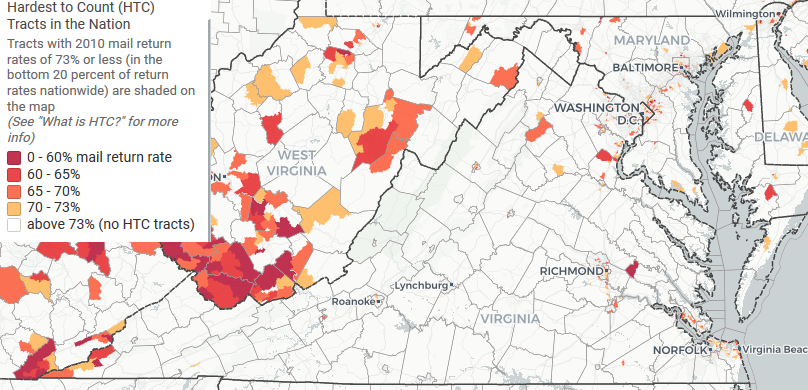
census tracts with a response rate less than 73 percent to 2010 questionaires may be the hard-to-count census tracts in 2020
Source: Census Bureau, Mapping Hard to Count (HTC) Communities for a Fair and Accurate 2020 Census

census tracts with a response rate less than 73 percent to 2010 questionaires may be the hard-to-count census tracts in 2020
Source: Census Bureau, Mapping Hard to Count (HTC) Communities for a Fair and Accurate 2020 Census
The Census Bureau has created 1,906 "census tracts" in Virginia within the 38 cities and 95 counties. Census tracts are designed to include about 4,000 people, with boundaries based primarily on permanent visible features so changes can be tracked over time. Census tracts do not cross county and state boundaries in order to count people within individual jurisdictions, so the edges of a tract are not always obvious.
Within a census tract are smaller units called "blocks," which have easy-to identify boundaries such as railroad tracks and rivers) so the assigned enumerator can make an accurate count. A collection of blocks forms a "block group" and a collection of block groups forms a census tract. Each of the political jurisdictions in Virginia will include at least one census tract.1
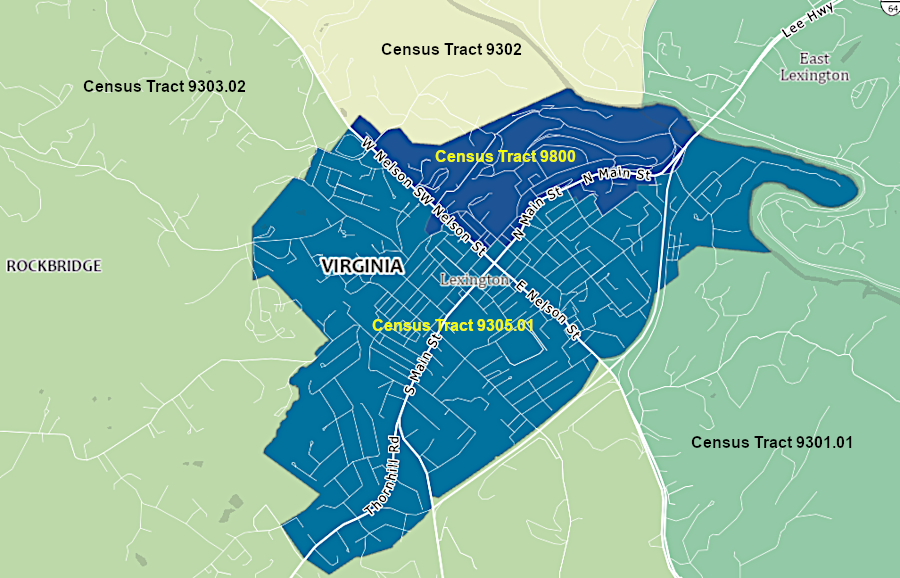
the City of Lexington is divided into two Census tracts
Source: Census Bureau, 2020 Census Demographic Data Map Viewer
To prepare for the 2020 Census, the Center for Urban Research in New York identified the census tracts with a low (less than 74%) response rate to the first questionnaire mailed to each house in 2010. Additional outreach efforts can be targeted to those tracts, to enhance getting a complete count in 2020. The Secretary of the Commonwealth estimated in 2019 that 45,000 people, roughly 0.5% of the Virginia residents on April 1, 2010, were not counted in the 2010 Census. The undercounts, which varied by state, affected the distribution of Federal grants between the states for the last decade.2
The total of those grants reached $675 billion dollars by 2018, so state officials sought to increase response rates for the 2020 Census. Governor Northan created a 40-member Virginia Complete Count Commission, in hopes that the "local knowledge, expertise, and influence" of its members would improve outreach and ultimately lead to a higher response rate.3

all residents on April 1 are supposed to be counted, independent of their citizenship or ability to speak English
Source: Census Bureau, 2020 Census: Tagline Available in Multiple Languages
In the 2010 Census, only 81% of Virginia residents had mailed back the forms to the Census Bureau. Enumerators had to contact the rest, and Virginia ended up #8 on the list of states which missed resident children. In 2019, Governor Northam requested $1.5 million in order to:4
A complete count was desired by Virginia officials because each resident missed in the count could result in an annual loss of $2,000 in Federal funding, for programs where funing is allocated based on population. Of the 132 Federal programs using population as a criterion, some of the most significant were Medicaid, Federal Direct Student Loans, Supplemental Nutrition Assistance Program ("food stamps"), Highway Planning and Construction, Head Start, Title I grants to school districts, Rural Electrification Loans and Loan Guarantees, and the Community Housing Impact and Preservation (CHIP) affordable housing program. In 2016, Virginia received over $17 billion allocated based on Census data for 55 large Federal programs.
The General Assembly blocked Gov. Northam's request for extra funding to enhance the accuracy of the 2020 Census, so he drew instead upon the Economic Contingency Fund where the governor had full discretion for allocations. At the time, plans for the census were highly partisan.
The Trump Administration was trying to add a question that required responders to identify if they were citizens. That question was expected to reduce the response rate from the 11-12 million undocumented residents in the United States, lowering the count of Hispanics from Mexico and Central America by 12% and keeping six million from responding. The question could have led to a later effort to draw election districts after the 2020 Census based on citizen population only, rather than total population. That approach would reduce the voting influence of Democrats, with their higher support from racial minorities.
Based on the American Community Survey, Arizona, California, Texas, New Mexico, and Colorado would be most effected by the reduced response rate. If the US Supreme Court had not blocked the addition of the citizenship question, Montana was projected to gain a second seat in the reapportionment of the 435 seats in the US House of Representatives. Alabama, Minnesota and Ohio would avoid losing a seat. California would lose two seats, while Teaxas would gain only one instead of two.5
The total of residents counted in Texas, Florida and Arizona was lower than predicted. The undercount could have deterred immigrants from responding to the Census, costing them an extra seat. Texas and Florida were reliably Republican states, so the Trump Administration efforts to deter immigrants from responding could have backfired.
As expected, Virginia did not gain or lose any seats in the US House of Representatives after the 2020 Census. The number of residents which altered Congressional representation was tiny in other states. Minnesota retained a seat by just 26 people. Had New York counted 89 more people, it would not have lost a seat in the House of Representatives. Thought the potential for error was relatively high in the 2020 Census due to the COVID-19 coronovirus and efforts by the Trump Administration to force people to identify if they were illegal immigrants, the statistics reported by the Bureau of Census were used for reapportionment.
Between 2010-2020, Virginia's population grew from 8,001,024 to 8,631,393, a 7.9% increase. Utah grew at the greatest rate, 18.4%. Three states saw a population drop - Illinois, Mississippi, and West Virginia. West Virginia lost the highest percentage, 3.2%.
Nationwide, the population grew to 331.5 million people on April 1, 2020. That was a 7.4% increase over 2010, the second-lowest growth rate in history. Only the 1930-40 decade, in which the Great Depression constrained people from starrting a family, was lower. The slow rate of growth reflected the low fertility rate as the baby boomer generation aged, plus low immigration rates. Since the fertility rate of 1.73 was below the 2.1 rate required to maintain a stable population, immigration was the factor that created population growth within the United States.6
The 2020 Census revealed that of all 95 counties, Highland County had the fewest residents. All of Highland County is in one Census tract. Tract boundaries are designed to include an average of 4,000 people, but those boundaries must also be within just one jurisdiction. There were e 74,134 tracts defined for the 2010 census.7
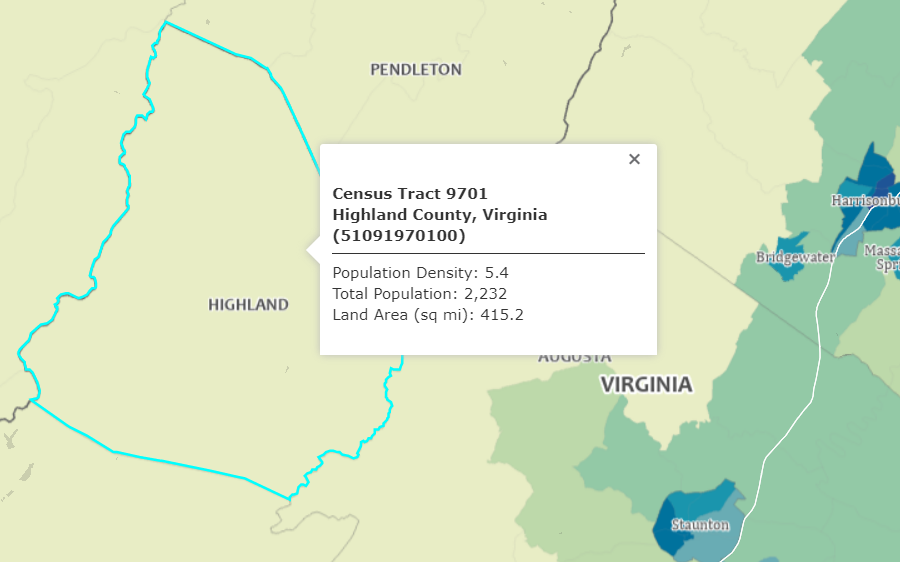
all of Highland County is in one Census tract
Source: Census Bureau, 2020 Census Demographic Data Map Viewer
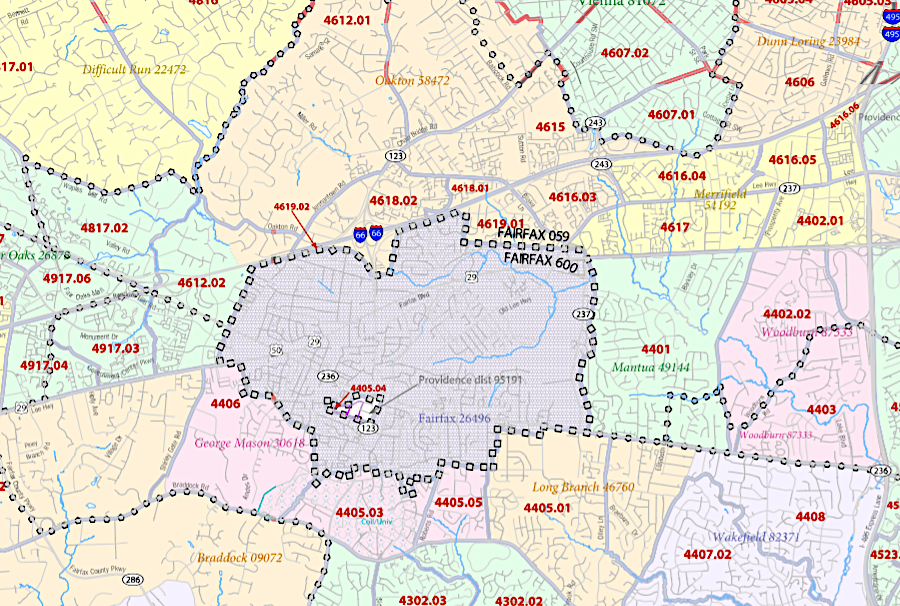
Census tract boundaries in Fairfax County do not extend into the independent City of Fairfax, but do include the judicial center which is county land completely surrounded by the city
Source: Census Bureau, 2020 Census - Census Tract Reference Map
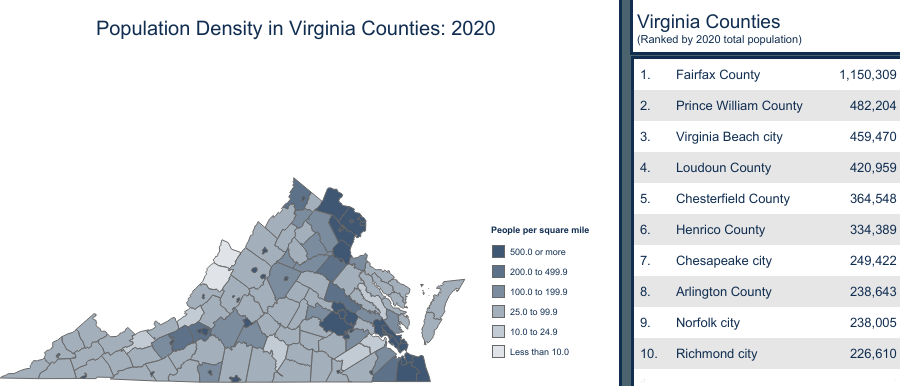
four cities were in the top 10 jurisdictions for total population in 2020
Source: Census Bureau, 2020 Population and Housing State Data
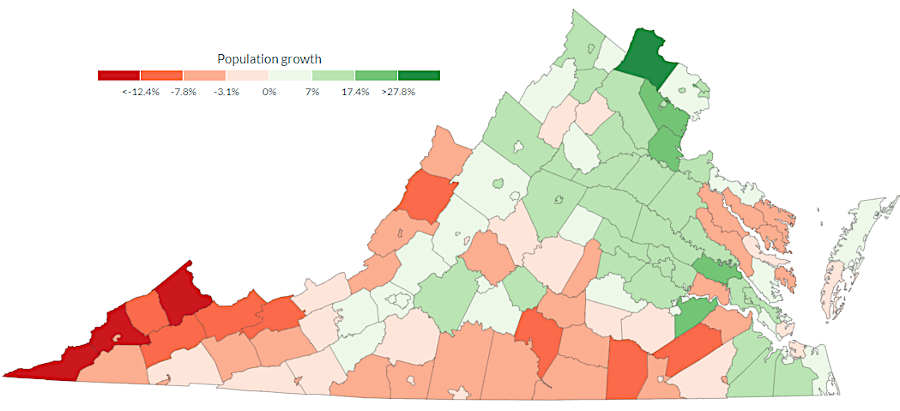
62 cities/counties, almost half of the 133 jurisdictions, lost population between 2010-2020
Source: Virginia Public Access Project, A Decade of Population Change
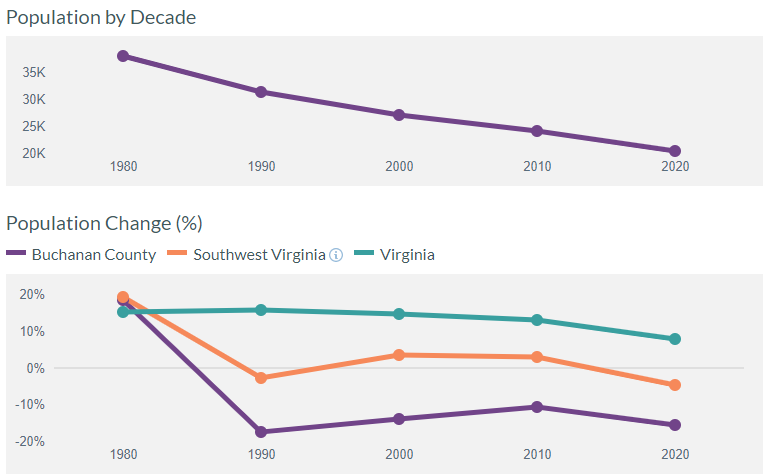
Buchanan County lost the geatest percentatage of population (-15.5%) between 2010-2020
Source: Virginia Public Access Project, Census 2020 - Buchanan County
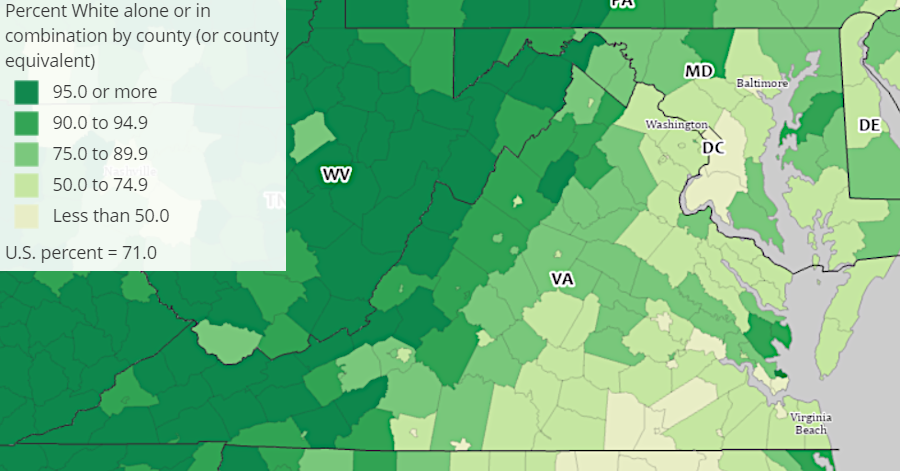
racial diversity west of the Blue Ridge is far lower than east of the mountains
Source: Bureau of Census, 2020 Census Demographic Data Map Viewer